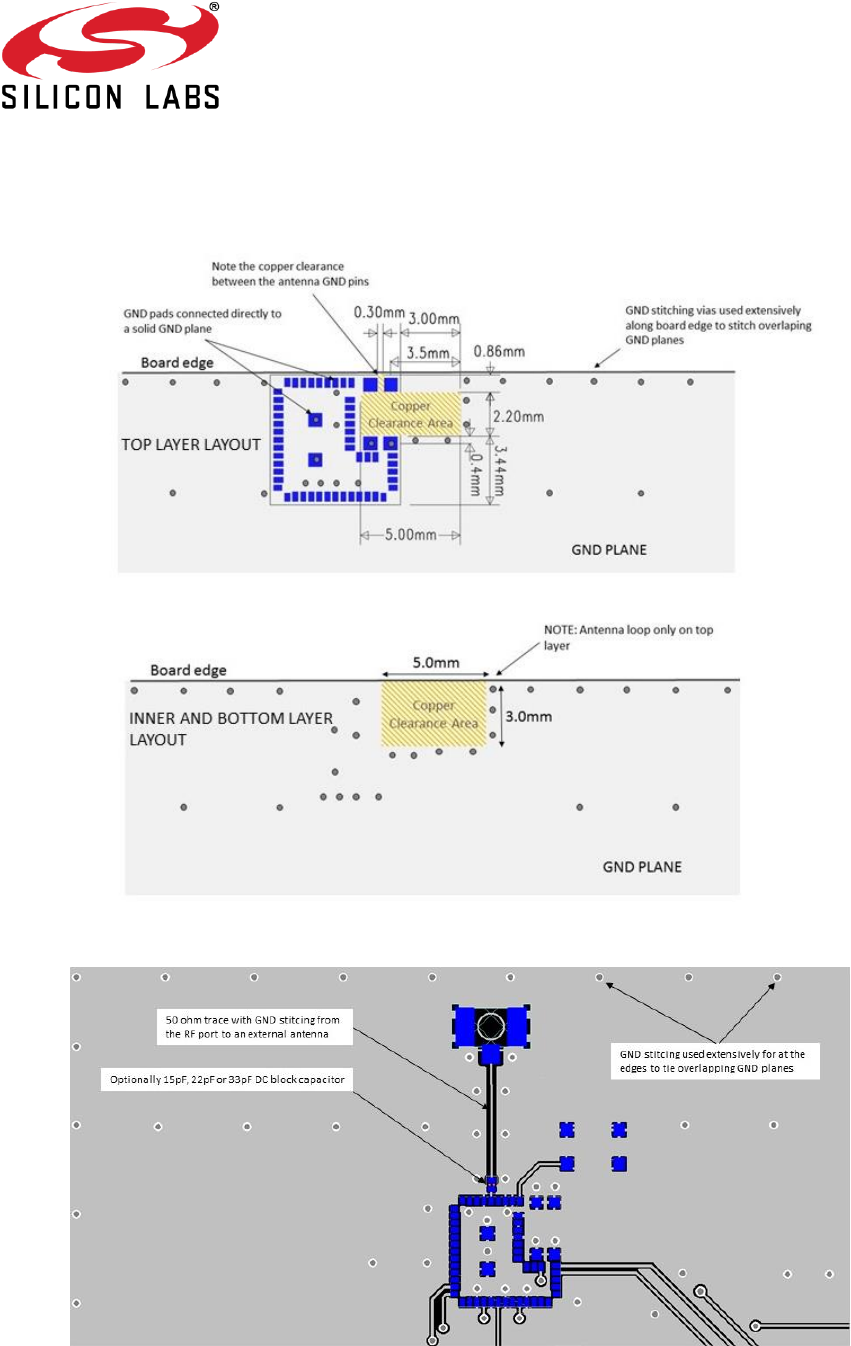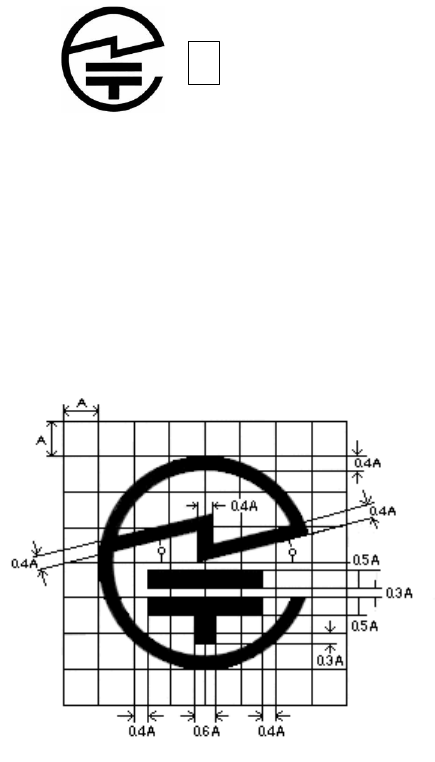Silicon Laboratories Finland BGM12LMA Blue Gecko BGM121 / BGM123 Bluetooth Smart Module User Manual
Silicon Laboratories Finland Oy Blue Gecko BGM121 / BGM123 Bluetooth Smart Module
Contents
- 1. User Manual
- 2. User manual
User Manual

Alberga Business Park, Bertel Jungin aukio 3
FI-02600 Espoo, Finland
Phone: +358 9 435 5060
www.silabs.com
INSTALLATION GUIDE
Figure 1: Layout guide for BGM121A/BGM123A
Figure 2: Layout guide for BGM121N/BGM123N
Page 2 of 7
QUALIFIED ANTENNA TYPES FOR
BGM121N/BGM123N
BGM121N/BGM123N modules are approved with a standard 2.14 dBi dipole antenna. Any
antenna of the same type, similar in-band out of band characteristics and with the same or
less gain can be used without reassessment. In case using antenna of a different type
and/or higher gain reassessments and notification to the particular certification authority is
required.

Page 3 of 7
Japan
BGM121A/BGM123A is certified in Japan with certification number 209-J00226.
IMPORTANT:
The module does is not labeled with Japan certification mark and ID because of the small
physical size. Manufacturer who integrates a radio module in their host equipment must
place the certification mark and certification number on the outside of the host equipment.
Figure 3: GITEKI mark and ID
The certification mark and certification number must be placed close to the text in the
Japanese language which is provided below.
当該機器には電波法に基づく、技術基準適合証明等を受けた特定無線設備を装着している。
Figure 4:GITEKI mark
R209-J00226

Page 4 of 7
FCC
This device complies with Part 15 of the FCC Rules. Operation is subject to the following two
conditions:
(1) this device may not cause harmful interference, and
(2) this device must accept any interference received, including interference that may cause
undesired operation.
Any changes or modifications not expressly approved by Silicon Labs could void the user’s authority to
operate the equipment.
FCC RF Radiation Exposure Statement:
This equipment complies with FCC radiation exposure limits set forth for an uncontrolled
environment. End users must follow the specific operating instructions for satisfying RF
exposure compliance. This transmitter meets both portable and mobile limits as
demonstrated in the RF Exposure Analysis and SAR test report. This transmitter must not be
co-located or operating in conjunction with any other antenna or transmitter except in
accordance with FCC multi-transmitter product procedures.
OEM Responsibilities to comply with FCC Regulations
The transmitter module must not be co-located or operating in conjunction with any other
antenna or transmitter except in accordance with FCC multi-transmitter product procedures.
Each new host will require reassessment of radiated spurious emissions and a permissive
change to the certification.
For BGM121N/BGM123N the minimum separation distance to human body is 6mm. If the
separation distance from the antenna to human body is 6mm or more, SAR testing is not
needed. In case the separation distance to human body is less than 6mm, then OEM
integrator is responsible to test the SAR with the end product assembly.
OEM integrator is responsible for testing their end-product for any additional compliance
requirements required with this module installed (for example, digital device emissions, PC
peripheral requirements, etc.).
IMPORTANT NOTE: In the event that the above conditions cannot be met (for certain
configurations or co-location with another transmitter), then the FCC authorization is no
longer considered valid and the FCC ID cannot be used on the final product. In these
circumstances, the OEM integrator will be responsible for re-evaluating the end product
(including the transmitter) and obtaining a separate FCC authorization.
End Product Labeling
The BGM121 module is not labeled with its own FCC ID because of its small physical size.
The final end product must be labeled in a visible area with the following:
“Contains Transmitter Module FCC ID: QOQBGM12LMA”
Page 5 of 7
or
“Contains FCC ID: QOQBGM12LMA
The OEM integrator has to be aware not to provide information to the end user regarding
how to install or remove this RF module or change RF related parameters in the user
manual of the end product.

Page 6 of 7
ISEDC
This radio transmitter (IC: 5123A-BGM12LMA) has been approved by Industry Canada to
operate with the embedded chip antenna. Other antenna types are strictly prohibited for use
with this device.
This device complies with Industry Canada’s license-exempt RSS standards. Operation is
subject to the following two conditions:
(1) This device may not cause interference; and
(2) This device must accept any interference, including interference that may cause
undesired operation of the device
RF Exposure Statement
Exception from routine SAR evaluation limits are given in RSS-102 Issue5. BGM121 and
BGM123 meets the given requirements when the minimum separation distance to human
body is less than equal to 15 mm. RF exposure or SAR evaluation is not required when the
separation distance is 15 mm or more.
BGM121A/BGM123A modules has been tested for worst case RF exposure. As
demonstrated in the SAR test report, BGM121A/BGM123A can be mounted in touch with
human body without further SAR evaluation.
If the separation distance of BGM121N or BGM123N is less than 15 mm the OEM integrator
is responsible for evaluating the SAR.
OEM Responsibilities to comply with IC Regulations
The transmitter module must not be co-located or operating in conjunction with any other
antenna or transmitter.
Radiated emission must be tested with each new host product and ISEDC must be notified
with a Class 4 Permissive Change.
OEM integrator is responsible for testing their end-product for any additional compliance
requirements required with this module installed (for example, digital device emissions, PC
peripheral requirements, etc.).
IMPORTANT NOTE: In the event that these conditions cannot be met (for certain
configurations or co-location with another transmitter), then the IC authorization is no longer
considered valid and the IC ID cannot be used on the final product. In these circumstances,
the OEM integrator will be responsible for re-evaluating the end product (including the
transmitter) and obtaining a separate IC authorization
End Product Labeling
The BGM121/BGM123 module is not labeled with IC ID because of its small physical size.
The final end product must be labeled in a visible area with the following:
“Contains Transmitter Module IC: 5123A-BGM12LMA”
or
“Contains IC: 5123A-BGM12LMA”
Page 7 of 7
The OEM integrator has to be aware not to provide information to the end user regarding
how to install or remove this RF module or change RF related parameters in the user
manual of the end product
CE
The Declaration of Conformity may be consulted at www.silabs.com.
Please note that every application using the BGM121 or BGM123 will need to perform the
radio EMC tests on the end product according to EN 301 489-17.
The conduced test results can be inherited from the modules test report to the test report of
the end product using BGM123 or BGM121. EN300328 radiated spurious emission test must
be repeated with the end product assembly. Test documentation and software for the EN
300 328 radiated spurious emissions testing can be requested from the Silicon Labs support.